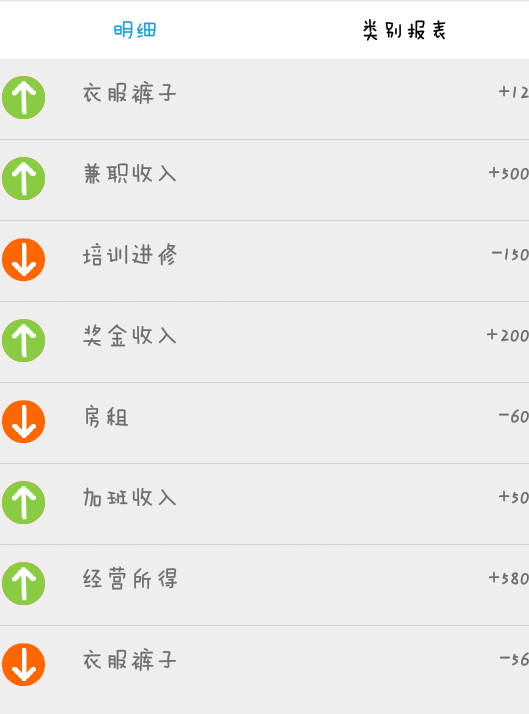前言: ListView這個列表控制項在Android中是最常用的控制項之一,幾乎在所有的應用程式中都會使用到它。 目前正在做的一個記賬本APP中就用到了它,主要是用它來呈現收支明細,是一個圖文列表的呈現方式,下麵就講講具體是如何實現的。 效果圖: 該功能是在另一篇博文【Android Studio 使 ...
前言:
ListView這個列表控制項在Android中是最常用的控制項之一,幾乎在所有的應用程式中都會使用到它。
目前正在做的一個記賬本APP中就用到了它,主要是用它來呈現收支明細,是一個圖文列表的呈現方式,下麵就講講具體是如何實現的。
效果圖:
該功能是在另一篇博文【Android Studio 使用ViewPager + Fragment實現滑動菜單Tab效果 --簡易版】的基礎上進行添加的

實現的思路:
1、該功能是用fragment來做佈局的,首先創建一個fragment.xml佈局文件,在裡面添加一個ListView控制項;
2、由於List裡面既要呈現圖片,也要呈現文字,所以再創建一個fragment_item.xml佈局文件,在裡面添加ImageView、TextView,用來顯示圖片和文字;
3、使用SimpleAdapter來綁定數據;
具體實現邏輯:
1、創建fragment_one.xml
1 <ListView 2 android:id="@+id/lv_expense" 3 android:layout_width="match_parent" 4 android:layout_height="wrap_content"> 5 6 </ListView>
2、創建fragment_one_item.xml
1 <ImageView 2 android:id="@+id/image_expense" 3 android:layout_width="wrap_content" 4 android:layout_height="wrap_content" 5 android:paddingTop="10dp" 6 android:paddingRight="10dp" 7 android:paddingBottom="10dp" 8 android:adjustViewBounds="true" 9 android:maxWidth="72dp" 10 android:maxHeight="72dp"/> 11 <TextView 12 android:id="@+id/tv_expense_category" 13 android:layout_width="wrap_content" 14 android:layout_height="wrap_content" 15 android:layout_weight="1" 16 android:padding="10dp"/> 17 <TextView 18 android:id="@+id/tv_expense_money" 19 android:layout_width="wrap_content" 20 android:layout_height="wrap_content" 21 android:text="10.0000"/>
3、主邏輯OneFragment.java
1 List<Map<String, Object>> listitem = new ArrayList<Map<String, Object>>(); //存儲數據的數組列表 2 //寫死的數據,用於測試 3 int[] image_expense = new int[]{R.mipmap.detail_income, R.mipmap.detail_payout }; //存儲圖片 4 String[] expense_category = new String[] {"發工資", "買衣服"}; 5 String[] expense_money = new String[] {"30000.00", "1500.00"}; 6 for (int i = 0; i < image_expense.length; i++) 7 { 8 Map<String, Object> map = new HashMap<String, Object>(); 9 map.put("image_expense", image_expense[i]); 10 map.put("expense_category", expense_category[i]); 11 map.put("expense_money", expense_money[i]); 12 listitem.add(map); 13 } 14 15 //創建適配器 16 // 第一個參數是上下文對象 17 // 第二個是listitem 18 // 第三個是指定每個列表項的佈局文件 19 // 第四個是指定Map對象中定義的兩個鍵(這裡通過字元串數組來指定) 20 // 第五個是用於指定在佈局文件中定義的id(也是用數組來指定) 21 SimpleAdapter adapter = new SimpleAdapter(getActivity() 22 , listitem 23 , R.layout.fragment_one_item 24 , new String[]{"expense_category", "expense_money", "image_expense"} 25 , new int[]{R.id.tv_expense_category, R.id.tv_expense_money, R.id.image_expense}); 26 27 ListView listView = (ListView) v.findViewById(R.id.lv_expense); 28 listView.setAdapter(adapter);
以上就是整個功能實現的邏輯,本文代碼中,List中呈現的數據是寫死的,從資料庫中獲取源數據的方式可以參考我的源代碼,且使用的資料庫是SQLite。
源代碼:https://github.com/AnneHan/ListViewDemo
SQLite資料庫的使用:Android Studio 通過一個登錄功能介紹SQLite資料庫的使用



